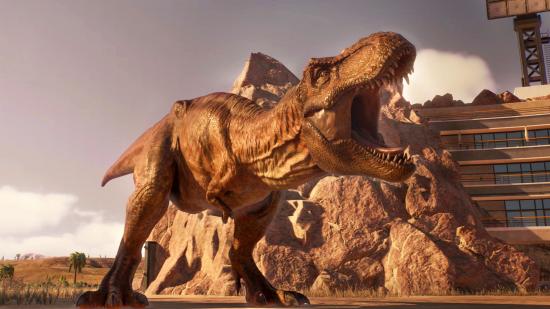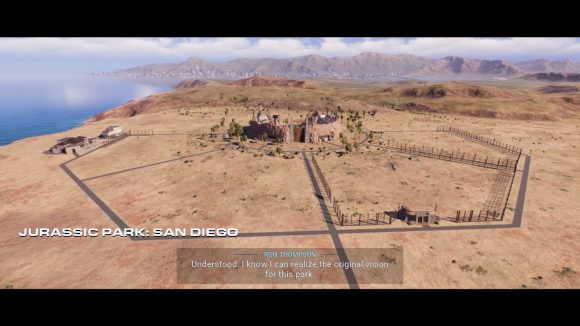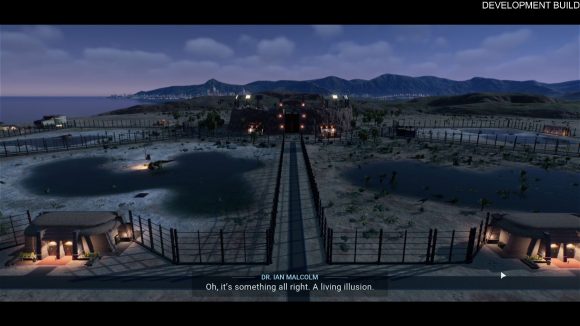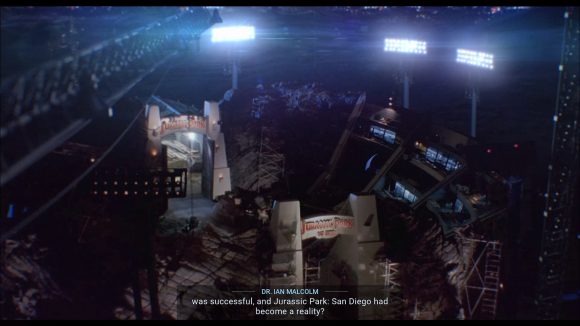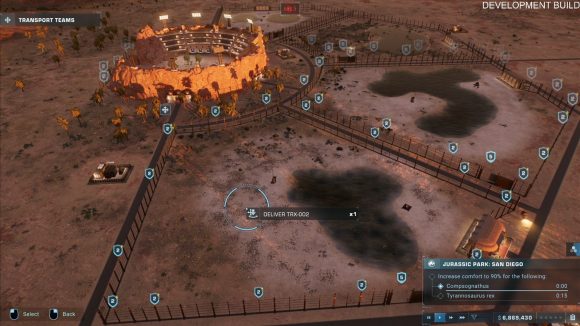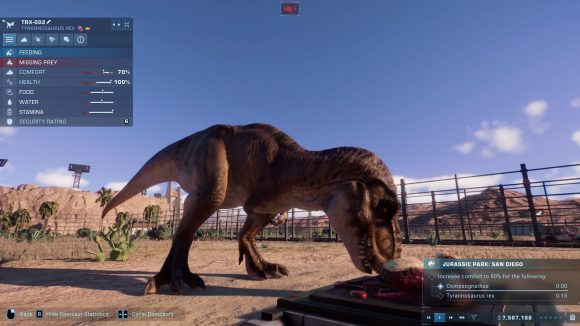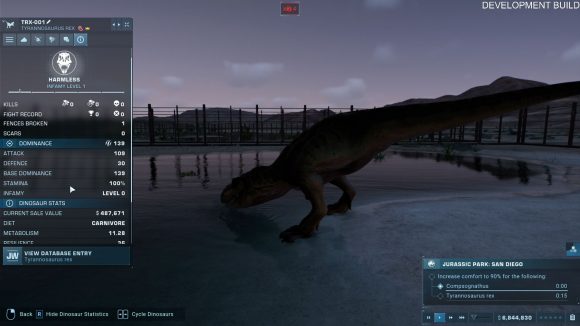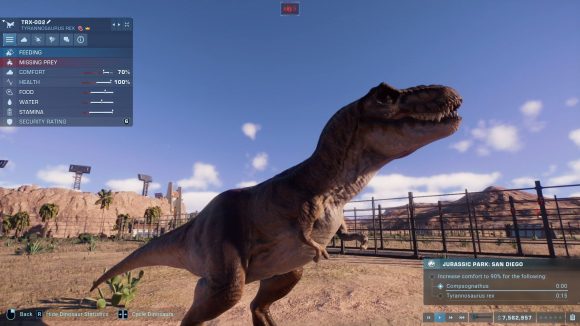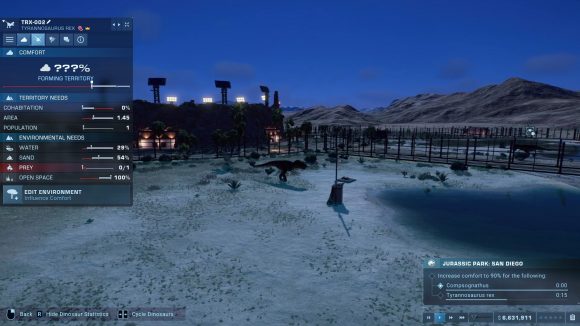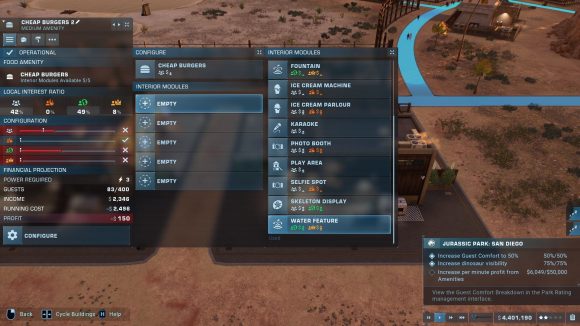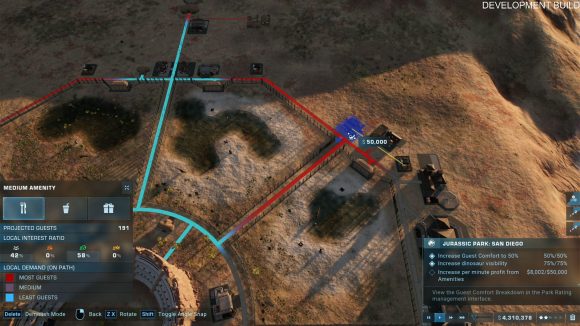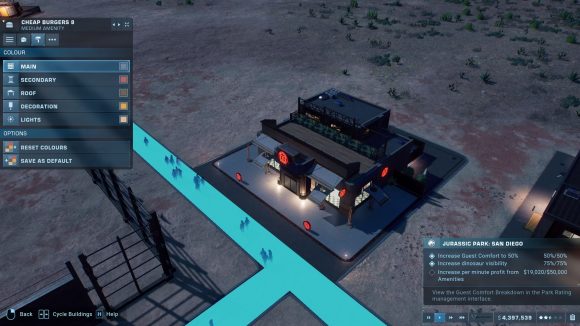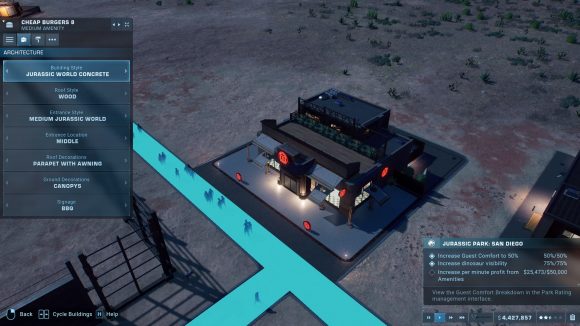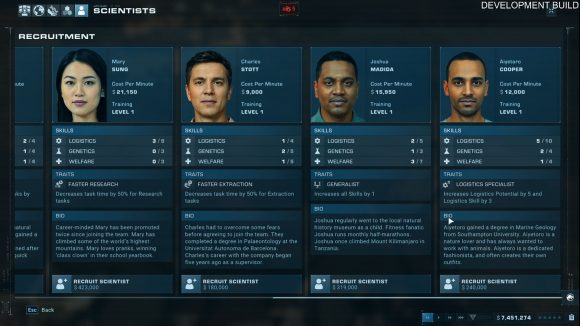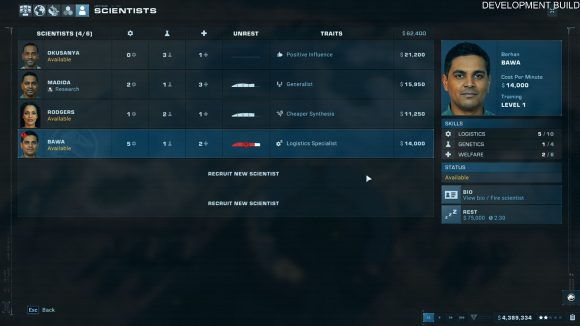Jurassic World Evolution got the important things right. It was a management game about building a park full of dinosaurs, and the dinosaurs were brilliant. Releasing an alpine-skinned Velociraptor from a hatchery as its sinister, twitchy face blinked and sniffed the air made me feel like a proud mother hen. Even when it went on to eat several guests.
But for all this goodwill, ‘JWE’ had a lot of frustrations. Based on roughly two hours’ play, Jurassic World Evolution 2 is an iterative sequel that takes precise aim at those frustrations, while also adding a fair bit of new meat to its predecessor’s bony frame.
The campaign opens with a stage-setting cinematic made of glossy slides, establishing a much more coherent premise than the original’s vaporous quest to dress up the Las Cinco Muertes archipelago. Picking up from where Jurassic World: Fallen Kingdom (the latest movie) left off, Jurassic World Evolution 2 charges you with rounding up the dinosaurs that are now roaming the continental United States, for their protection and ours.
This means building not just amusement parks, but also containment habitats; the tutorial mission has me herding stegosauruses and a wandering baryonyx (oddly non-threatening despite being long-snouted and very toothy, perhaps because it’s now pescatarian) into enclosures just to keep them safe. With a whole continent to play with and a backstory full of corporate competition, greed, and humanity’s arrogance in the face of nature’s will, it’s a premise that could stretch to missions with many different objectives and challenges, though I’m not counting my genetically modified chickens just yet. We do know the game will explore a much wider variety of environments – desert, taiga, and temperate – than the first game’s tropical islands.
It’s tantalising but I don’t get to see much of it, because after completing the tutorial mission I’m ushered into a scenario from the game’s Chaos Theory mode for the remaining 90 minutes of my hands-on time. These are JWE2’s ‘what if?’ missions, like what if the Indominus Rex disaster in Jurassic World had been averted or, in this instance, what if InGen’s Jurassic Park: San Diego had actually opened? Pleasingly, the map features a number of enclosures around a central amphitheatre – just like the park’s design in Jurassic Park lore.
Between these two missions I get a pretty clear handle on what’s changed in the basics. The three factions are gone – thank goodness – and your staff are individual scientists now, who can be hired, fired, trained, and assigned tasks such as research and expeditions. Each scientist also has an ‘unrest’ meter, which builds as they work, and if they get fed up then they may act against you; game director Rich Newbold compares this to Dennis Nedry’s disgruntlement at John Hammond in the first movie. If sabotage occurs now, it’ll be because you worked your people too hard, not because you failed to please everybody in a system that made it hard to do so if you also wanted to progress.
I love that sabotage is more directly linked to a decision, though the cost for simply letting your scientists take a break when they need it seems pretty mild. Newbold points out that you need to build a staff centre before you can do so, and that staff still cost you money while they’re resting, so there’s that. Also, “in some of the challenge mode levels you’re racing to complete the level in a certain time,” which might mean you can’t afford to wait to get the DNA for that shiny spiny spinosaurus that’ll give your park the ratings boost it needs. If you’re just up for a leisurely stroll through the campaign, though, these projects are less time sensitive, so perhaps the game will succeed in offering the best of both worlds.

Not that the first game’s problem of occasionally arbitrary challenge has entirely gone away. At one point a sandstorm distresses my poor stegosaurus so much that it busts out of its enclosure, and Newbold confirms that hurricanes that directly damage enclosures are still a thing. I guess they’re a thing in the films, too, but my problem with them is the same as with putting natural disasters in Civilization VI. It’s not just that they’re arbitrary. It’s that the decisions they force on you aren’t interesting. Plenty of other decisions are, and when these are interrupted by a random storm that unleashes one of my T-Rexes, I don’t think ‘cool! A fun new problem to solve!’. I roll my eyes, open the shelters, issue a bunch of reflexive orders to repair the fence, tranq and replace the asset, and then return to what I was doing feeling nothing but mild annoyance.
Perhaps this kind of thing was more necessary in the first game because without it, there weren’t enough decisions to make. My session with the sequel is just long enough to see how Frontier is trying to fix this, if not to judge whether it’s succeeded. Essentially, both dinosaurs and guests are much more complicated now. Herbivores graze on the foliage that you put in their habitat – which makes so much sense that it’s baffling plant feeders were even a thing – but they have far more sophisticated diets, and will demand their preferred menu of fibre, fruit, nuts, and leaves. With the new and varied biomes, dinosaurs have intricate terrain preferences, too: my T-Rex sulks when there isn’t enough sand in its paddock, so I put some in, which it then nuzzles contentedly with its snout. It’s rather adorable.
This feeds into the all-new territory system, with dinosaurs seeking out their preferences within their enclosures and dynamically defining their home turf as they do so. I didn’t get to see any tensions arise from this system, but as your park expands and you have to fit ever more dinosaurs into ever less space, Newbold hopes it’ll force some interesting decisions. “If you want to put lots of dinosaurs in a small space, do you have enough space to put in enough ground nuts and ground fruit for them all to be happy? And the territory they need will get bigger as you add more dinosaurs – two ankylosaurids will need a certain amount of space, but five will need more.”
Your guests are similarly demanding, and now fall into multiple subcategories, each looking for something different in their visit to a dinosaur theme park. Presumably they all still want to not get eaten, but some will appreciate a closer look at deadlier dinosaurs than others, and their tastes in food and souvenirs will also vary. You’ll cater to these by building a mix of shops and eateries, customising not only what they sell and at what price, but also picking a set of extensions to make them more appealing to certain guest types.
Most of the equivalent management systems in JWE didn’t really go deep enough, but there’s plenty to fiddle with here. It’s far too early to say whether such fiddling will ultimately be rewarding, but so far it looks like Frontier has identified all the right priorities in iterating on Jurassic World Evolution.
The sequel is due on November 9 – check out the Steam page here. Alternatively, seek out our roundup of the best simulation games or tycoon games on PC.
